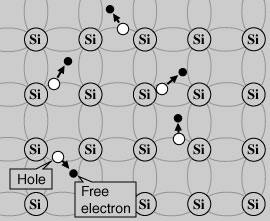- A pure semiconductor is called intrinsic semiconductor. It has thermally generated current carriers.
- They have four electrons in the outermost orbit of atom and atoms are held together by covalent Bond.
- Free electrons and holes both are charge carriers and ne(in C.B.) = nh(in V.B.)
- The drift velocity of electrons (ve) is greater than that of holes (vh)
- For them fermi energy level lies at the centre of the C.B. and V.B.
- In pure semiconductor, impurity must be less than 1 in 108 parts of semiconductor.
- In intrinsic semiconductor
ne(0) =nh(0)=ni
where,
ne(0) = Electron density in conduction band
nh(0)= Hole density in V.B.
ni = Density of intrinsic carriers
- The fraction of electrons of valance band present in conduction band is given by f µ = e–Ee/kT; where Eg = Fermi energy or k = Boltzmann’s constant and T= Absolute temperature.

